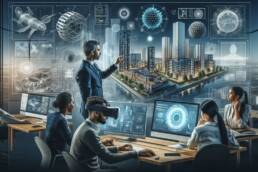In the rapidly evolving field of architecture and construction, 3D architectural visualization stands as a transformative force, reshaping the industry by enhancing design visualization, marketing strategies, and construction processes. CG Viz Studio, a professional 3D visualization company, exemplifies this revolution by offering services that allow architects, developers, and marketers to previsualize their projects with stunning realism and engage clients with interactive experiences. The future of design is being reimagined through the lens of advanced 3D modeling, rendering, and virtual reality technologies.
Key Takeaways
- 3D architectural visualization provides a realistic preview of projects, aiding decision-making and marketing efforts.
- Technological advancements in rendering and virtual reality have elevated architectural presentations to immersive experiences.
- Interactive visuals foster client engagement and enable real-time feedback, streamlining the design process.
- Marketing and sales strategies are bolstered by photorealistic imagery and virtual tours, enhancing the pre-construction vision.
- 3D visualization tools are integral to modern architectural education, preparing the next generation with cutting-edge skills.
Revolutionizing Project Visualization
The Advent of 3D Modeling and Rendering
We have witnessed a transformative era in architectural design with the advent of 3D modeling and rendering. These technologies have revolutionized the way we visualize projects, turning conceptual ideas into detailed models ready for production. From digitally shaping conceptual ideas to advanced detailed models, 3D modeling software has become an indispensable tool in our industry.
Interactive visuals have elevated client engagement, allowing for real-time feedback and adjustments. This shift from static blueprints to dynamic models has not only improved communication but also enhanced the overall design process. Here’s a glimpse into the impact of these advancements:
- Detailed and accurate representations of projects
- Facilitated communication among stakeholders
- Reduced time and resources in design and modeling
We now have the ability to create immersive architectural imagery that brings our clients’ visions to life with unprecedented clarity.
Embracing these tools has allowed us to offer a range of services that cater to the diverse needs of our clients. Whether it’s architectural visualization, interior design, or product development, the use of 3D rendering services is on the rise, providing quick creation of photorealistic images that captivate and communicate more effectively than ever before.
From Blueprints to Virtual Reality: The Evolution of Architectural Presentation
We’ve witnessed a transformative shift from traditional blueprints to the immersive world of virtual reality (VR) and augmented reality (AR) in architectural presentation. These technologies have not only revolutionized the way we visualize spaces but also enhanced the overall design process. 3D architectural visualization has become a cornerstone in this evolution, providing photorealistic views that bring projects to life long before the first stone is laid.
- Immersive Experiences: VR allows clients to fully immerse themselves in the proposed environment, experiencing the space as if it were already built.
- Interactive Presentations: AR enables the overlay of digital models onto physical sites, offering a unique perspective that merges the proposed with the existing.
- Enhanced Visualization: 3D modeling and rendering transform 2D plans into vivid 3D representations, making it easier for everyone to understand the scope and details of a project.
By integrating these advanced tools, we facilitate a more collaborative and engaging experience for clients, stakeholders, and design teams alike. The ability to walk through a space, make real-time adjustments, and see the impact of those changes instantaneously is invaluable.
As we continue to push the boundaries of architectural presentation, the benefits of these technologies become increasingly clear. They not only revolutionize architectural presentation but also optimize design and construction processes, leading to more informed decisions and ultimately, better-built environments.
Client Engagement and Real-Time Feedback with Interactive Visuals
We’ve embraced the power of 3D visualization to transform client interactions into dynamic, collaborative experiences. Early engagement with clients is now possible, allowing them to provide feedback from the very beginning. This not only improves client satisfaction but also streamlines the design process, making it more efficient and customer-friendly.
Interactive presentations have revolutionized the way we share our designs. By utilizing VR and AR technologies, clients can navigate through virtual spaces, gaining insights that were once impossible with traditional blueprints. This immersive approach leads to more informed decision-making and a deeper understanding of the project’s spatial qualities.
Our commitment to integrating emerging technologies ensures that we stay at the forefront of design iteration, enhancing both the effectiveness and efficiency of our work.
Here’s how 3D visualization enhances our workflow:
- Client Presentations: More interactive and dynamic, setting clear expectations.
- Design Iteration: Incorporating client feedback effectively and promptly.
- Decision Making: Clients gain a better grasp of design scale, proportion, and ambiance.
By fostering this level of engagement, we’re not just designing spaces; we’re crafting experiences that resonate with our clients’ visions and aspirations.
Enhancing Marketing and Sales Strategies
Photorealistic Imagery as a Powerful Sales Tool
We’ve witnessed firsthand how advanced 3D renderings revolutionize real estate marketing with photorealism, enhancing buyer engagement and streamlining design processes for collaborative and innovative outcomes. The ability to present a property in its best light before the first brick is laid is not just a convenience—it’s a game-changer.
Photorealistic imagery allows clients to visualize the end result with stunning accuracy, making it easier for them to commit to a purchase. This visual certainty is a powerful sales tool, as it reduces the time spent on decision-making and increases the likelihood of a sale. Here’s how we leverage photorealistic imagery in our sales strategy:
- Showcasing properties in their most attractive form
- Offering virtual tours to immerse clients in the space
- Creating interactive experiences that allow for customization
By providing a tangible experience through visuals, we’re not just selling a concept; we’re selling a reality that clients can connect with emotionally.
The impact of these visuals on the sales process is undeniable. We’ve seen a significant reduction in the time it takes to close a sale, and feedback from clients has been overwhelmingly positive. They appreciate the ability to see and interact with their future homes or commercial spaces, which in turn fosters trust and satisfaction.
Virtual Tours and Animations: Selling the Vision Before Construction
We’ve embraced the power of virtual tours and animations to sell the vision of a project before the first stone is laid. Clients can now walk through their future spaces, experiencing the scale, textures, and lighting, all from the comfort of their current home or office. This immersive experience is not just a powerful sales tool; it’s a transformative way to connect emotionally with a space.
Virtual reality and animations allow for a dynamic presentation of the project, highlighting key features and potential of the space. Here’s how we leverage these tools:
- Providing a virtual walkthrough of the property
- Showcasing different design options and finishes
- Demonstrating the functionality of spaces with animated sequences
- Allowing clients to experience different times of day and lighting conditions
By offering these interactive experiences, we’re not just selling a design; we’re selling a dream. The ability to visualize their future environment in such a tangible way often leads to quicker decision-making and enhanced client satisfaction.
Our approach has proven effective, with clients frequently expressing their appreciation for the clarity and insight provided by these visualizations. It’s a testament to the fact that when clients can see and interact with their future space, their confidence in the project—and in us—soars.
Leveraging 3D Visuals in Digital Marketing Campaigns
We’ve witnessed firsthand the transformative power of 3D visualization in digital marketing. By offering interactive experiences and immersive product showcases, we’re not just presenting a concept; we’re bringing it to life. 3D visualization enhances marketing campaigns with dynamic presentations that adapt to market demands and client feedback, ensuring our message resonates with the intended audience.
Our approach to integrating 3D visuals into marketing strategies is multifaceted. We focus on creating photorealistic imagery that captivates and engages potential clients, making it easier for them to envision the final product. This not only accelerates the decision-making process but also fosters a deeper connection with the project.
Here’s how we leverage 3D visuals effectively:
- Crafting error-free and detailed renderings for clear communication
- Utilizing virtual tours to provide a comprehensive view of future projects
- Implementing animations to depict the functionality and aesthetics of designs
- Distributing high-quality content across various digital platforms for maximum reach
By embracing these techniques, we ensure that our marketing efforts are not just seen but experienced. The result is a more informed and enthusiastic client base, ready to move forward with confidence.
Streamlining Design and Construction Processes
Collaborative Design Development with 3D Visualization
We’ve embraced the transformative power of 3D architectural visualization to foster a more collaborative design process. By creating detailed and interactive models, we enable all stakeholders to participate actively in the development phase. This real-time collaboration results in a more cohesive and refined final design, ensuring that everyone’s vision is aligned and integrated into the project.
The ability to visualize complex structures and design elements in three dimensions has revolutionized our approach to architectural design. It allows for immediate feedback and iterative improvements, which are essential in achieving excellence in our work.
Here are some of the key benefits we’ve observed:
- Enhanced communication among architects, clients, and contractors
- Quicker consensus on design decisions
- Reduced misunderstandings and errors
- Streamlined approval processes
By leveraging 3D visualization, we’re not just designing buildings; we’re building a shared understanding and a stronger foundation for our projects.
Error Detection and Prevention in Pre-Construction Stages
We understand the critical importance of identifying potential design issues before breaking ground. 3D architectural visualization serves as a powerful tool, enabling us to detect errors early in the design process. This proactive approach not only saves time but also significantly reduces costs associated with post-construction corrections.
Iterative Design and Refinement:
- Visualize structures in three dimensions to spot potential issues
- Collaborate with stakeholders to refine designs iteratively
- Optimize functionality and minimize errors for robust architectural solutions
By leveraging 3D models, we provide stakeholders with a tangible understanding of the final product, facilitating a more informed decision-making process.
The use of 3D visualization in error detection and prevention is not just a theoretical advantage; it has practical implications. For instance, if a wall inadvertently obstructs a view, it’s far simpler to adjust a model than to modify a built structure. Similarly, material choices can be assessed for aesthetic and functional harmony before they are ordered and installed. This level of preemptive quality control is invaluable in maintaining the integrity of the design and ensuring client satisfaction.
Facilitating Efficient Project Approvals and Stakeholder Communication
We’ve seen firsthand how 3D architectural visualization streamlines the approval process and enhances stakeholder communication. By providing a tangible understanding of the final product, stakeholders can make informed decisions quickly, reducing the time from concept to construction. Early detection of design issues is another critical benefit, allowing for adjustments before costly mistakes occur.
The iterative nature of 3D modeling means potential issues are identified and addressed early, leading to robust architectural solutions.
Here are some key advantages:
- Cost efficiency: Minimizes risks and material waste.
- Speed of construction: Accelerates project timelines.
- Design flexibility: Allows for complex and bespoke designs.
- Sustainability: Encourages eco-friendly practices.
Our experience aligns with the feedback from industry professionals who have noted significant cost reductions in project management and enhanced accuracy in measurements and material choices. This not only saves time and money but also ensures a smoother communication flow, making it easier for everyone to understand and provide feedback on the designs.
Expanding Creative Horizons
Breaking Boundaries with Innovative Design Possibilities
We are witnessing an era where the flexibility of CAD software and the advent of 3D printing are empowering us to push the limits of architectural design. Innovative technologies are enabling the creation of complex geometries and forms that were once considered unattainable. This not only challenges traditional aesthetics but also opens up new avenues for functionality and expression in our built environment.
- Sustainability: Promotes environmentally friendly practices through efficient material use and recyclability.
- Innovation in forms and structures: Unlocks new possibilities in architectural design, challenging traditional aesthetics and functionality.
The journey of architectural innovation is marked by both challenges and opportunities. It invites us to contribute to a more sustainable, efficient, and imaginative world. As we embrace these new tools, we find ourselves reimagining the future of architecture in profound and exciting ways.
Incorporating Complex Geometries and Advanced Materials
We are witnessing a transformative era in architectural design where the integration of complex software solutions is pivotal. The use of 3D architectural visualization tools allows us to embrace complex geometries and advanced materials that were once considered unattainable. These technologies enable architects to push the boundaries of creativity and innovation, crafting structures that are not only aesthetically pleasing but also structurally sound and sustainable.
- Cost efficiency: Reduces material waste and streamlines the construction process.
- Speed of construction: Enables rapid prototyping and building, accelerating project timelines.
- Design flexibility: Facilitates complex geometries and bespoke designs previously considered unfeasible.
- Sustainability: Promotes environmentally friendly practices through efficient material use and recyclability.
However, we must also be cognizant of the challenges that come with these advancements. Technical limitations, material constraints, and regulatory issues are hurdles that we continue to address. As we refine these innovative technologies, our goal is to enhance accuracy, realism, and integration with building processes, revolutionizing the construction industry.
Embracing these new possibilities requires a commitment to continuous learning and adaptation. The future of architecture is unfolding before us, and it is our responsibility to harness these tools to create spaces that are not only visually compelling but also reflective of our values and aspirations.
Sustainable Design and Visualization: A New Era of Eco-Friendly Architecture
We are witnessing a transformative era where sustainable design and 3D architectural visualization converge, heralding a new age of eco-friendly architecture. The fusion of 3D rendering and green home technology is not just a trend; it’s a commitment to the future of our planet. By integrating advanced visualization techniques with sustainable practices, we are able to explore innovative design solutions that prioritize environmental responsibility.
Our approach to sustainable architecture goes beyond energy efficiency. It encompasses the use of recycled materials, the reduction of waste, and the creation of spaces that coexist harmoniously with their natural surroundings.
The benefits of this integration are manifold:
- Enhanced planning and resource management: By visualizing projects in 3D, we can optimize the use of materials and reduce waste.
- Informed material selection: Virtual models allow us to experiment with various sustainable materials and their impact on the environment.
- Client engagement: Interactive visuals enable clients to appreciate the value of sustainable features in their projects.
As we continue to embrace these practices, we are not only designing buildings but also shaping a more sustainable and efficient world.
The Future of Architectural Education and Training
Integrating 3D Visualization into Curriculum
We recognize the transformative power of 3D visualization in architectural education. By integrating 3D visualization into the curriculum, we’re equipping students with the skills necessary to excel in a rapidly evolving industry. The adoption of VR in architecture education can significantly enhance learning outcomes, providing an immersive experience that traditional methods cannot match.
In an experience-driven world, the integration of virtual tours into the curriculum enables students to access renowned architectural creations and landmarks by simply donning a VR headset. This not only democratizes education by removing geographical barriers but also allows for a deeper understanding of spatial relationships and design aesthetics.
Our commitment to incorporating advanced visualization tools into educational frameworks is unwavering. We believe that hands-on experience with these technologies is crucial for fostering innovation and creativity in future architects.
To illustrate the impact of 3D visualization on student engagement, consider the following points:
- Mastery of 3D modeling software becomes a fundamental skill, akin to learning the language of modern architectural design.
- Real-time rendering capabilities allow students to experiment with lighting, materials, and environmental settings, receiving instant visual feedback.
- Collaborative projects become more dynamic, as students can share and critique virtual models in ways that paper sketches cannot convey.
Preparing the Next Generation of Architects with Cutting-Edge Tools
We recognize the imperative to equip the next generation of architects with the most advanced tools available. Mastering Architecture Visualization is not just about learning software; it’s about embracing a mindset that welcomes innovation and experimentation. The flexibility of CAD software, for example, allows for rapid iteration of designs, enabling students to explore a multitude of possibilities without the constraints of traditional methods.
As educators, we must foster an environment where students are encouraged to push the boundaries of design and technology.
To ensure our students are industry-ready, we integrate a variety of tools into our curriculum:
- 3D Modeling and Rendering
- Interactive Virtual Reality (VR) Simulations
- Advanced Material and Lighting Techniques
- Real-Time Design Collaboration Platforms
These tools are not just for creating impressive visuals; they are essential for understanding complex geometries and for effective communication with clients and stakeholders. By immersing students in the latest technology, we prepare them to be agile and responsive in a rapidly evolving field.
The Role of Virtual Reality in Architectural Pedagogy
We are witnessing a paradigm shift in architectural education, where virtual reality (VR) and augmented reality (AR) are becoming integral tools in the curriculum. These technologies are transforming architectural education by providing immersive experiences that closely mimic real-world environments. Students can now explore and interact with their designs in a fully realized 3D space, enhancing their understanding of scale, texture, and spatial relationships.
- Immersive learning through VR simulations
- Enhanced design comprehension with interactive models
- Real-time collaboration in virtual workspaces
By integrating VR and AR into pedagogy, we are not only enriching the learning experience but also preparing students for the future demands of the industry. These tools allow for a more engaging and interactive form of education, where theoretical knowledge is seamlessly blended with practical application.
The impact of these technologies is not limited to the classroom; they also facilitate better communication and collaboration among students and educators. As we continue to explore the potential of VR and AR in education, we are setting a new standard for how architects are trained, ensuring they are adept at using the latest tools to bring their visions to life.
As the architectural industry evolves, so must the education and training of its professionals. CG Viz Studio is at the forefront of this transformation, offering cutting-edge 3D visualization services that are essential for the modern architect. To stay ahead of the curve and ensure your skills remain relevant in a rapidly changing environment, visit our website and explore our extensive portfolio, services, and career opportunities. Take the first step towards the future of architectural education by clicking the link below.
Conclusion
In the realm of architectural design and construction, the advent of 3D Architectural Visualization has marked a significant paradigm shift. This technology has not only redefined the presentation and conceptualization of architectural projects but has also empowered architects, developers, and clients with the ability to preview and refine their visions with unprecedented clarity. The testimonials and experiences shared by CG Viz Studio’s clients underscore the transformative effects of these services, highlighting enhanced communication, efficiency, and the delivery of high-quality, photorealistic visualizations. As we look to the future, it is evident that 3D visualization will continue to be an indispensable tool, driving innovation and shaping the built environment in ways we are only beginning to imagine.
Frequently Asked Questions
What is 3D Architectural Visualization?
3D Architectural Visualization is the process of creating digital models of buildings or spaces before they are actually built. It involves using advanced software to build 3D models from blueprints or design concepts, which are then rendered into highly realistic images or animations.
How does 3D Visualization transform the design process?
3D Visualization transforms the design process by allowing architects and clients to see what their projects will look like in real life, facilitating decision-making on design, materials, and more. It also enables real-time feedback and interactive visuals, enhancing client engagement.
Can 3D Visualization help in marketing and selling projects?
Yes, 3D Visualization is a powerful tool for marketing and sales. Photorealistic imagery and virtual tours can effectively showcase a project before construction, helping to sell the vision to potential buyers or investors and leveraging digital marketing campaigns.
What role does 3D Visualization play in construction?
In construction, 3D Visualization aids in collaborative design development, error detection and prevention in pre-construction stages, and facilitates efficient project approvals and communication with stakeholders.
How is 3D Visualization influencing architectural education?
3D Visualization is being integrated into architectural curricula to prepare the next generation of architects with cutting-edge tools. It plays a significant role in architectural pedagogy by providing immersive and interactive learning experiences.
What future advancements can we expect in 3D Architectural Visualization?
Future advancements in 3D Architectural Visualization may include more immersive and interactive visualizations, further bridging the gap between concept and reality. Technological innovations will continue to enhance the visualization quality and capabilities.



